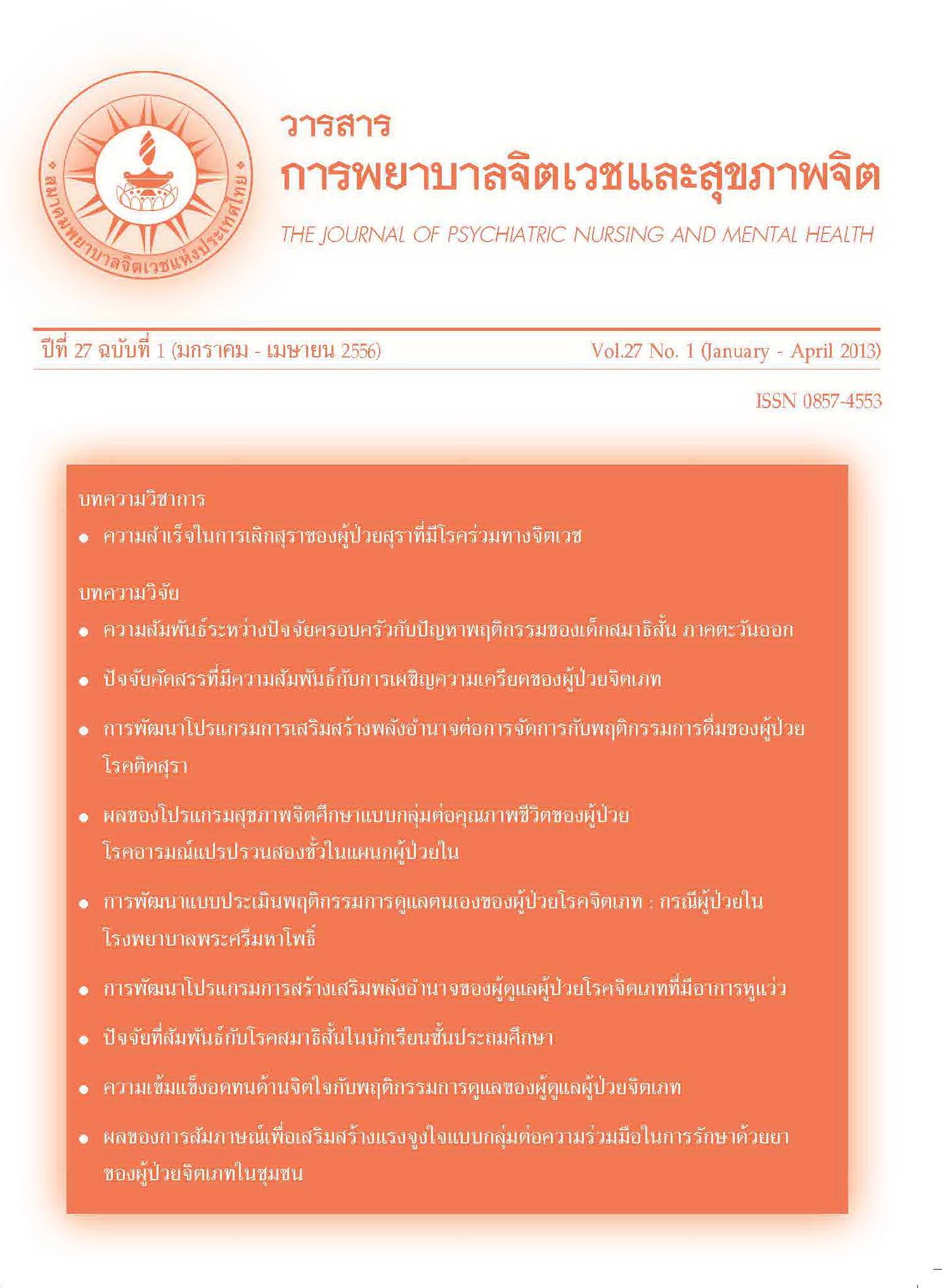ปัจจัยที่สัมพันธ์กับโรคสมาธิสั้นในนักเรียนชั้นประถมศึกษา
Main Article Content
บทคัดย่อ
บทคัดย่อ
การวิจัยเชิงวิเคราะห์ภาคตัดขวางครั้งนี้มีวัตถุประสงค์เพื่อศึกษาปัจจัยที่สัมพันธ์กับโรคสมาธิสั้นในนักเรียนชั้นประถมศึกษา กลุ่มตัวอย่างเป็นนักเรียนชั้นประถมศึกษาปีที่ 1-5 จำนวน 7,805 คน จำแนกตามสังกัดการศึกษาใน 10 จังหวัด จาก 4 ภาค และกรุงเทพมหานคร โดยกลุ่มตัวอย่างที่เข้าร่วมโครงการได้รับการคัดกรองด้วยแบบแบบคัดกรองโรคสมาธิสั้น SNAP-IV ฉบับภาษาไทย (Thai version of Swanson, Nolan and Pelham IV) และได้รับการวินิจฉัยโรคสมาธิสั้นโดยจิตแพทย์เด็กและวัยรุ่นตามเกณฑ์ DSM-IV พบว่า กลุ่มตัวอย่างเป็นโรคสมาธิสั้น จำนวน 521 คน และไม่ได้เป็นโรคสมาธิสั้น จำนวน 6,667 คนเก็บรวบรวมข้อมูลโดยใช้แบบสอบถามเกี่ยวกับปัจจัยด้านเด็กและผู้ปกครอง วิเคราะห์ข้อมูลโดยสถิติร้อยละ ค่าเฉลี่ย ส่วนเบี่ยงเบนมาตรฐาน และวิเคราะห์ถดถอยโลจิสติค
ผลการวิจัย พบว่า ปัจจัยที่ร่วมอธิบายโรคสมาธิสั้นได้แก่ เด็กเพศชายเสี่ยงเป็น 3.7 เท่าของเพศหญิง เด็กที่อาศัยอยู่กับญาติเสี่ยง 1.6 เท่าของเด็กที่อยู่กับพ่อแม่ เด็กที่เคยมีประวัติเรียนซ้ำชั้น หรือเคยถูกครูลงโทษเสี่ยงเป็น 1.9 และ 2.8 เท่าของเด็กที่ไม่เคย ครอบครัวที่มีสถานภาพสมรส หย่าร้างหรือแยกกันอยู่ หรือเป็นหม้ายเสี่ยงเป็น 1.7 เท่าของครอบครัวที่อยู่ร่วมกันปกติ พ่อที่การศึกษาจบมัธยมศึกษาหรือต่ำกว่าเสี่ยงเป็น 1.6 เท่า ครอบครัวที่มีรายได้ไม่เพียงพอและมีหนี้สินเสี่ยงเป็น 1.4 เท่า พ่อมีประวัติปัญหาพฤติกรรมซนอยู่ไม่นิ่ง เสพสารเสพติด หรือก่อกวนผู้อื่นเสี่ยงเป็น 2.0, 2.0 และ 1.5 เท่า และผู้ปกครองที่ไม่มีความรู้เรื่องโรคสมาธิสั้นเสี่ยงเป็น 2.3 เท่า
คำสำคัญ : โรคสมาธิสั้น, ความสัมพันธ์, นักเรียนประถมศึกษา
Abstract
The purpose of this cross-sectional analytical study was to examine the relationship between factors of Attention Deficit/ Hyperactivity Disorders (ADHD) in school-age children. The samples were 7,805 of Thai students in primary school from grade 1 to 5 by regions in ten provinces of four regions in Thailand and Bangkok. The samples were screened by using SNAP-IV Thai parent version and interviewed by child and adolescent psychiatrists using DSM-IV criteria of ADHD. Five hundred and twenty-one ADHD children and 6,667 non-ADHD children. Data collection was a set of questionnaire including: risk factors of child and family. Descriptive statistic and multiple logistic regression with backward stepwise were used for examined the association between factors and ADHD.
The factors associated with Attention Deficit-Hyperactivity Disorder in primary school students were male had risk more 3.7 times than female, children who living with relatives had risk more 1.6 times than with parents, children who were repeatedly in class and punished by teacher had risk more 1.9 and 2.8 times. Parents who were widow, divorced, or separated had been greater risk 1.7 times than married couples. Family with insufficient income and debt had risk 1.4 times, the father who had history of inattention/hyperactivity, drug addicted, or disruptive behavior had risk more 2.0, 2.0, and 1.5 times. Particularly, parents who did not have knowledge of ADHD had greater risk 2.3 times
Keywords : ADHD, associated factors, school-age children
Article Details
บทความที่ได้รับการตีพิมพ์แล้ว เป็นลิขสิทธิ์ของสมาคมพยาบาลจิตเวชแห่งประเทศไทย

